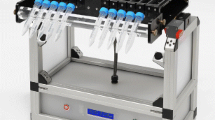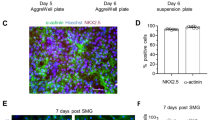Summary
We are studying microenvironmental cues which contribute to neuroendocrine organ assembly and tissue-specific differentiation. As our in vitro model, we cultured rat adrenal medullary PC12 pheochromocytoma cells in a novel cell culture system, the NASA rotating wall vessel (RWV) bioreactors. This “simulated microgravity” environment in RWV bioreactors, characterized by randomizing gravitational vectors and minimizing shear stress, has been shown to favor macroscopic tissue assembly and to induce tissue-specific differentiation. We hypothesized that the unique culture conditions in the RWV bioreactors might enhance the in vitro formation of neuroendocrine organoids. To test our hypothesis, we evaluated the expression of several markers of neuroendocrine differentiation in cultures of PC12 cells maintained for up to 20 d in the slow turning lateral vessel (STLV) type RWV. PC12 cell differentiation was assessed by morphological, immunological, biochemical and molecular techniques. PC12 cells, cultured under “simulated microgravity” conditions, formed macroscopic, tissue-like organoids several millimeters in diameter. Concomitantly, the expression of phenylethanolamine-N-methyl transferase (PNMT), but not of other catecholamine synthesizing enzymes, was enhanced. Increased PNMT expression, as verified on both the gene and protein level, was accompanied by an increase in the specific activity of the enzyme. Furthermore, after 20 d in culture in the STLV, we observed altered patterns of protein tyrosine phosphorylation and prolonged activation of c-fos, a member of the AP-1 nuclear transcription factor complex. We conclude that culture conditions in the RWV appear to selectively activate signal transduction pathways leading to enhanced neuroendocrine differentiation of PC12 cells.
Similar content being viewed by others
References
Anderson, D. J. Molecular control of cell fate in the neural crest: the sympathoadrenal lineage. Ann. Rev. Neurosci. 16:129–158; 1993.
Bacallao, R.; Antony, C.; Dotti, C., et al., The subcellular organization of Madin-Darby canine kidney cells during the formation of a polarized epithelium. J. Cell Biol. 109:2817–2832; 1989.
Becker, J. L.; Prewett, T. L.; Spaulding, G. F., et al. Three-dimensional growth and differentiation of ovarian tumor cell line in high aspect rotating-wall vessel: morphologic and embryologic considerations. J. Cell. Biochem. 51:283–289; 1993.
Bell, E. Tissue engineering: a perspective. J. Cell. Biochem. 45:239–241; 1991.
Bethea, C. L.; Kozak, S. L. Effect of extracellular matrix on PC12 cell shape and dopamine processing. Mol. Cell. Endocrinol. 37:319–329; 1984.
Bethea, C. L.; Kozak, S. L. Further characterization of substratum influence on PC12 cell shape and dopamine processing. Mol. Cell. Endocrinol. 42:59–72; 1985.
Bohn, M. C.; Goldstein, M.; Black, I. B. Role of glucocorticoids in expression of the adrenergic phenotype in rat embryonic adrenal gland. Dev. Biol. 82:1–10; 1981.
Borriello, F.; Lederer, J. Construction of quantitative RT-PCR MIMICs. Biotechniques 19:580–584; 1995.
Byrd, J. C.; Alho, H. Differentiation of PC12 pheochromocytoma cells by sodium butyrate. Brain Res. 428:151–155; 1987.
Byrd, J. C.; Hadjiconstantinou, M.; Cavalla, D. Epinephrine synthesis in the PC12 phenochromocytoma cell line. Eur. J. Pharmacol. 127:139–142; 1986.
Byrd, J. C.; Naranjo, J. R.; Lindberg, I. Proenkephalin gene expression in the PC12 pheochromocytoma cell line: stimulation by sodium butyrate. Endocrinology 121:1299–1305; 1987.
Chong, J. A.; Tapia-Ramírez, J.; Kim, S., et al. REST: a mammalian silencer protein that restricts sodium channel gene expression to neurons. Cell 80:949–957; 1995.
Ebert, S. N.; Wong, D. L. Differential activation of the rat phenylethanolamine N-methyltransferase gene by Sp1 and Egr-1. J. Biol. Chem. 270:17299–17305; 1995.
Ehrlich, M. E.; Evinger, M. U.; Joh, T. H., et al. Do glucocorticoids induce adrenergic differentiation in adrenal cells of neural crest origin? Dev. Brain Res. 50:129–137; 1989.
Evinger, M.; Joh, T. H.; Reis, D. Transcriptional regulation of phenylethanolamine N-methyl transferase gene expression. In: Joh, T. H., ed. Catecholamine genes. Vol. 9. New York: Wiley-Liss; 1990:137–146.
Freshney, R. I. Culture of animal cells. A manual of basic technique. Third edition. New York: Wiley-Liss, Inc.; 1994.
Fujita, K.; Lazarovici, P.; Guroff, G. Regulation of the differentiation of PC12 pheochromocytoma cells. Environ. Health Perspect. 80:127–142; 1989.
Galvan, D. L.; Liu, J.; Wankowski, D. M., et al. Differential modulation of extracellular matrix protein expression in adrenal medullary cells cultured under simulated microgravity conditions. Mol. Biol. Cell 6:S975; 1995.
Gilbert, S. F. Developmental Biology. 3rd edition. Sunderland, MA: Sinauer Associates, Inc.; 1991.
Goodwin, T. J.; Jessup, J. M.; Wolf, D. A. Morphologic differentiation of colon carcinoma cell lines HT-29 and HT-29KM in rotating-wall vessels. In Vitro Cell. Dev. Biol. 28A:47–60; 1992.
Goodwin, T. J.; Prewett, T. L.; Wolf, D. A., et al. Reduced shear stress: a major component in the ability of mammalian tissues to form three-dimensional assemblies in simulated microgravity. J. Cell. Biochem. 51:301–311; 1993.
Goodwin, T. J.; Schroeder, W. F.; Wolf, D. A., et al. Rotating-wall vessel coculture of small intestine as a prelude to tissue modeling: aspects of simulated microgravity. Proc. Soc. Exp. Biol. Med. 202:181–192; 1993.
Greene, L. A.; Tischler, A. S. Establishment of a noradrenergic clonal line of rat adrenal pheochromocytoma cells which respond to nerve growth factor. Proc. Natl. Acad. Sci. USA 73:2424–2428; 1976.
Hwang, O.; Kim, M. L.; Lee, J. D. Differential induction of gene expression of catecholamine biosynthetic enzymes and preferential increase in norepinephrine by forskolin. Biochem. Pharmacol. 48:1927–1934; 1994.
Jaeger, C. B.; Aebischer, P.; Tresco, P. A., et al. Growth of tumour cell lines in polymer capsules: ultrastructure of encapsulated PC12 cells. J. Neurocytol. 21:469–480; 1992.
Jessup, J. M.; Goodwin, T. J.; Garcia, R., et al. STS-70: first flight of EDU-1. In Vitro Cell. Dev. Biol. 32A:13A; 1996.
Jessup, J. M.; Goodwin, T. J.; Spaulding, G. Prospects for use of microgravity-based bioreactors to study three-dimensional host-tumor interactions in human neoplasia. J. Cell. Biochem. 51:290–300; 1993.
Jessup, J. M.; Nachman, A.; Ford, R. D. Low shear stress of NASA Rotating Wall Vessel (RWV) increases CO2 and acid production while supporting differentiation in three-dimensional cultures. In Vitro Cell. Dev. Biol. 31A:8A; 1995.
Karl, M.; Saviolakis, G. A.; Gravanis, A., et al. The PC12 rat pheochromocytoma cell line expresses the prodynorphin gene and secretes the 8 kDa dynorphin product. Regul. Pept. 61:99–104; 1996.
Kim, K. T.; Park, D. H.; Joh, T. H. Parallel up-regulation of catecholamine biosynthetic enzymes by dexamethasone in PC12 cells. J. Neurochem. 60:946–951; 1993.
Klement, B. J.; Spooner, B. S. Pre-metatarsal skeletal development in tissue culture at unit- and microgravity. J. Exp. Zool. 269:230–241; 1994.
Kloth, S.; Ebenbeck, C.; Kubitza, M., et al. Stimulation of renal microvascular development under organotypic culture conditions. FASEB J. 9:963–967; 1995.
Koller, M. R.; Papoutsakis, E. T. Cell adhesion in animal cell culture: physiological and fluid-mechanical implications. In: Hjortso, M. A.; Roos, J. W., ed Cell adhesion: fundamentals and biotechnological applications. Vol. 3. New York, Basel, Hong Kong: Marcel Dekker, Inc.; 1994:61–110.
Lelkes, P. I. “Our” PC12 cells synthesize and secrete epinephrine. 6th International Symposium on Chromaffin Cell Biology. (Abstract) 1991:58.
Lelkes, P. I.; Manolopoulos, E. G.; Chick, D. M., et al. Endothelial cell heterogeneity and organ-specificity. In: Maragoudakis, M. E.; Gullino, P.; Lelkes, P. I., ed. Angiogenesis: molecular biology, clinical aspects. New York: Plenum Press; 1994:15–28.
Lelkes, P. I.; Ramos, E. M.; Chick, D. M., et al. Microgravity decreases tyrosine hydroxylase expression in rat adrenals. FASEB J. 8:1177–1182; 1994.
Lelkes, P. I.; Unsworth, B. R. Role of heterotypic interactions between endothelial cells and parenchymal cells in organospecific differentiation: a possible trigger of vasculogenesis. In: Maragoudakis, M. E.; Gullino, P.; Lelkes, P. I., ed. Angiogenesis in health and disease. New York: Plenum Press; 1992:27–43.
McKeehan, W. L.; Barnes, D.; Reid, L., et al. Frontiers in mammalian cell culture. In Vitro Cell. Dev. Biol. 26:9–23; 1990.
Mizrachi, Y.; Lelkes, P. I.; Ornberg, R. L., et al. Specific adhesion between pheochromocytoma (PC12) cells and adrenal medullary endothelial cells in co-culture. Cell. Tissue Res. 256:365–372; 1989.
Mizrachi, Y.; Narranjo, J.; Levi, B.-Z., et al. PC12 cells differentiate into chromaffin cell like phenotype in co-culture with adrenal medullary endothelial cells. Proc. Natl. Acad. Sci. USA 87:6161–6165; 1990.
Morita, K.; Ebert, S. N.; Wong, D. L. Role of transcription factor Egr-1 in phorbol ester-induced phenylethanolamine N-methyltransferase gene expression. J. Biol. Chem. 270:11161–11167; 1995.
Papadimitriou, E.; Unsworth, B. R.; Maragoudakis, M. E., et al. Time course and quantification of extracellular matrix maturation in the chick chorioallantoic membrane and in cultured endothelial cells. Endothelium 1:207–219; 1993.
Prewett, T. L.; Goodwin, T. J.; Spaulding, G. F. Three-dimensional modeling of T-24 human bladder carcinoma cell line: a new simulated microgravity culture vessel. J. Tissue Cult. Meth. 15:29–36; 1993.
Rasouly, D.; Shavit, D.; Zuniga, R., et al. Staurosporine induces neurite outgrowth in neuronal hybrids (PC12EN) lacking NGF receptors. J. Cell. Biochem. 62:356–371; 1996.
Rausch, D. M.; Iacangelo, A. L.; Eiden, L. E. Glucocorticoid-and nerve growth factor-induced changes in chromogranin A expression define two different neuronal phenotypes in PC12 cells. Mol. Endocrinol. 2:921–927; 1988.
Ross, M. E.; Evinger, M. J.; Hyman, S. E., et al. Identification of a functional glucocorticoid response element in the phenylethanolamine N-methyl transferase promoter using fusion genes introduced into chromaffin cells in primary culture. J. Neurosci. 10:520–530; 1990.
Saadat, S.; Stehle, A. D.; Lamouroux, A., et al. Influence of cell-cell contact on levels of tyrosine hydroxylase in cultured bovine adrenal chromaffin cells. J. Biol. Chem. 262:13007–13014; 1987.
Saadat, S.; Thoenen, H. Selective induction of tyrosine hydroxylase by cell-cell contact in bovine adrenal chromaffin cells is mimicked by plasma membranes. J. Cell Biol. 103:1991–1997; 1986.
Schneeberger, C.; Speiser, P.; Kury, F., et al. Quantitative detection of reverse transcriptase-PCR products by means of a novel and sensitive DNA stain. PCR Meth. Appl. 4:234–238; 1995.
Schoenherr, C. J.; Anderson, D. J. The neuron-restrictive silencer factor (NRSF): a coordinate repressor of multiple neuron-specific genes. Science 267:1360–1363; 1995.
Schwarz, R. P.; Goodwin, T. J.; Wolf, D. A. Cell culture for three-dimensional modeling in rotating-wall vessels: an application of simulated microgravity. J. Tissue Cult. Meth. 14:51–58; 1992.
Siebert, P. D.; Larrick, J. W. Competitive DNA fragments for use as internal standards in quantitative PCR. Biotechniques 14:244–249; 1993.
Spooner, B. S.; Hardman, P.; Paulsen, A. Gravity in mammalian organ development: differentiation of cultured lung and pancreas rudiments during spaceflight. J. Exp. Zool. 269:212–222; 1994.
Stachowiak, M. K.; Hong, J. S.; Viveros, O. H. Coordinate and differential regulation of phenylethanolamine N-methyl transferase, tyrosine hydroxylase and proenkephalin mRNAs by neural and hormonal mechanisms in cultured bovine adrenal medullary cells. Brain Res. 510:277–288; 1990.
Stein, R.; Orit, S.; Anderson, D. J. The induction of a neural-specific gene, SCG10, by nerve growth factor in PC12 cells is transcriptional, protein synthesis dependent, and glucocorticoid inhibitable. Dev. Biol. 127:316–325; 1988.
Tischler, A. S.; Greene, L. A. Morphologic and cytochemical properties of a clonal line of rat adrenal pheochromocytoma cells which respond to nerve growth factor. Lab. Invest. 39:77–89; 1978.
Wong, D. L.; Siddall, B.; Wang, W. Hormonal control of rat adrenal phenylethanolamine N-methyl transferase. Enzyme activity, the final critical pathway. Neuropsychopharmacology 13:223–234; 1995.
Youdim, M. B. H.; Heldman, E.; Pollard, H. B., et al. Contrasting monoamine oxidase activity and tyramine induced catecholamine release in PC12 and chromaffin cells. Neuroscience 19:1311–1318; 1986.
Zimmerman, K.; Mannhalter, J. W. Technical aspects of quantitative competitive PCR. Biotechniques 21:268–279; 1996.
Author information
Authors and Affiliations
Rights and permissions
About this article
Cite this article
Lelkes, P.I., Galvan, D.L., Thomas Hayman, G. et al. Simulated microgravity conditions enhance differentiation of cultured PC12 cells towards the neuroendocrine phenotype. In Vitro Cell.Dev.Biol.-Animal 34, 316–325 (1998). https://doi.org/10.1007/s11626-998-0008-y
Received:
Accepted:
Issue Date:
DOI: https://doi.org/10.1007/s11626-998-0008-y




